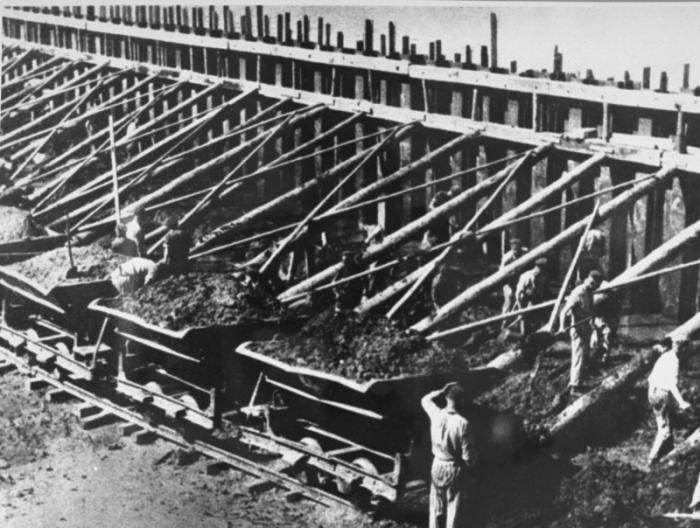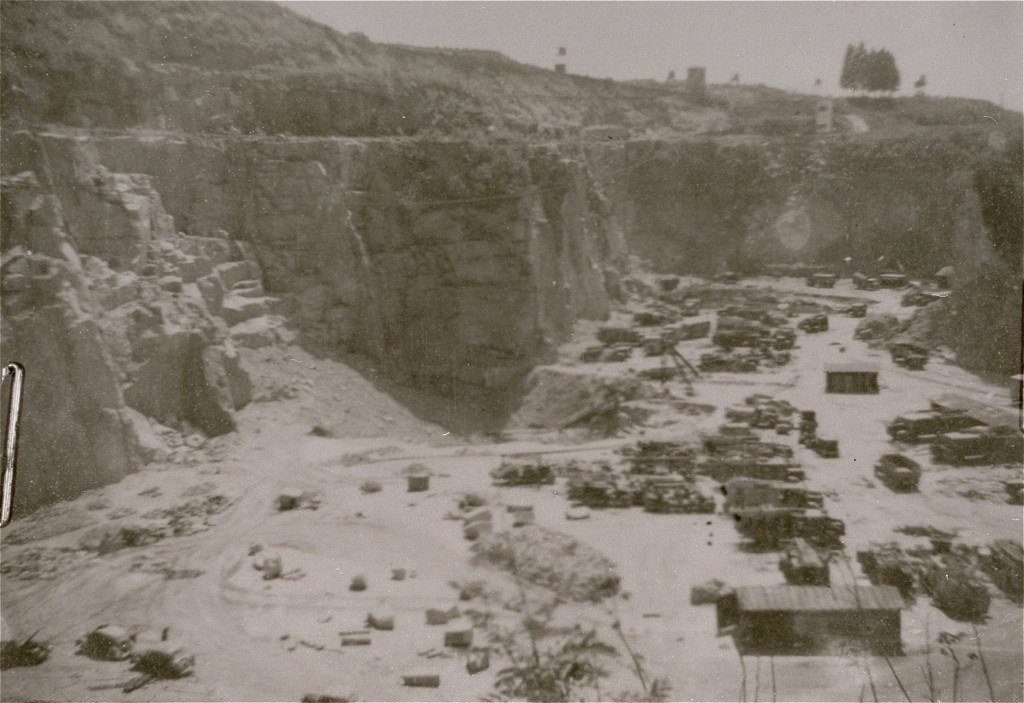
Forced Labor: In Depth
Before the Nazi seizure of power, many German law enforcement, social work, and welfare professionals as well as many ordinary German citizens believed that compulsory labor was a productive way to integrate social “outsiders” into the local labor force. They believed that labor would habituate these "outsiders" to proper social habits and personal discipline. These so-called outsiders included
- persons receiving welfare benefits
- juveniles and others engaged in petty crime
- persons unable for whatever reason to hold down a job
- persons who engaged in socially unacceptable behavior, such as excessive consumption of alcohol or promiscuous sexual activity
The basic notion, shared by professionals and ordinary citizens elsewhere in Europe and in North America, was that maintenance of social “order” was dependent upon the productive labor of all citizens, and that those who could or would not engage themselves on their own initiative should be compelled to do so.
Nazi ideology also identified hard manual labor as a preferred means not only of punishing intellectual opponents, but also of "educating" Germans to be "racially conscious" and to support the racial goals of National Socialism. From the establishment of the first concentration camps and detention facilities in the winter of 1933, forced labor—often pointless and humiliating, and imposed without proper equipment, clothing, nourishment, or rest—formed a core part of the concentration camp regimen. By labeling those incarcerated in the concentration camps as criminals, subversives, and asocials who would be “educated” in the camps to proper labor and social discipline, the Nazi leadership could draw upon acquiescence and even support among the German people for the concentration camps.

As early as 1937, the Reich economy began to experience labor shortages in key sectors. As the Nazi leadership prepared Germany for war, the SS leadership in the concentration camp system saw the prisoner population as a convenient reservoir of forced laborers to produce construction materials for the future SS settlements in eastern Europe. These settlements would mark the nerve centers of the “Thousand-Year Reich.” For this reason, many of the concentration camps established in the mid-1930s were located near quarries or factories: for example, Sachsenhausen (1936) was constructed next to a brickworks; Mauthausen (1938) and Gross-Rosen (1940) next to stone quarries.
After 1938, the Nazis increasingly exploited the forced labor of "enemies of the state," so-called asocials, and so-called criminal elements for economic gain and to meet desperate labor shortages. In 1938, the German Criminal Police conducted two major roundups of so-called asocials and so-called criminals to increase the number of forced laborers available in the camps. Initial plans to house large numbers of Soviet prisoners of war and, later, Jewish forced laborers at Auschwitz-Birkenau and Lublin/Majdanek in the winter of 1941-1942 also aimed at creating a captive labor force for the grandiose construction plans of the SS.
In addition to the SS, the German civilian authorities also required inexpensive labor for more immediate construction, urban renewal, and transportation projects. By the end of 1938, German municipal authorities deployed German and Austrian Jews, most of whom had been deprived of independent employment opportunities by antisemitic legislation, at forced labor at a variety of municipal projects.
When Germany conquered Poland in the autumn of 1939 and established the Generalgouvernement, the German occupation authorities required all Jewish and Polish males to perform unpaid forced labor. The German authorities required Polish Jews to live in ghettos and deployed them at forced labor, much of it manual. For example, in the Lodz ghetto, German state and private entrepreneurs established 96 plants and factories that produced goods for the German war effort.
After the Germans invaded the Soviet Union and the Soviets halted the invaders before Moscow in the late autumn of 1941, the German economy, needing to produce for a long war, developed an insatiable need for forced labor. Already in 1941, the SS authorities deployed tens of thousands of Jewish prisoners at forced labor in the I.G. Farben “Buna” rubber plant at Monowitz, less than two miles from the Auschwitz concentration camp in German-occupied Poland. As early as summer 1940, regional SS and civilian authorities in occupied Poland exploited Jews as forced laborers in special forced-labor camps for Jews under SS, German civilian, or German military jurisdiction.
After the major shooting operations in the occupied Soviet Union in 1941-1942 and the major operations to deport Jews in occupied Poland to the killing centers in 1942-1943, most of the remaining Jews in occupied Poland and the Soviet Union survived as forced laborers in these special camps for Jews or in concentration camps. During the implementation of the “Final Solution," the ability to work offered the chance of survival to Jews, for those deemed unable to work were the first to be shot or deported.
In the spring of 1942, Himmler reorganized the administration of the concentration camps, linking them to the SS Business Administration in the SS Economic and Administrative Main Office. The purpose of these administrative changes was to mobilize concentration camp labor for broader deployment in the German armaments and related industries. Between 1942 and 1945, hundreds of subcamps of concentration camps were established adjacent to coal mines, munitions and aircraft parts factories, sites for underground tunnels, and other sites convenient to production of goods for the German war effort. In the summer of 1942, for example, Auschwitz-Monowitz, or Auschwitz III, became a subcamp of Auschwitz.
Beginning in 1940, the German authorities rounded up Polish civilians, male and female, and deported them to the Reich for forced labor in German factories and on German farms. After deliberately permitting more than two million captured Soviet soldiers to die through neglect (insufficient food, clothing, shelter, or medical care) in prisoner-of-war camps in the autumn and winter of 1941-1942, the German authorities decided to deploy Soviet POWs as forced laborers in various war-related industries in Germany and occupied Poland, often housing them in special compounds of concentration camps. From 1942 to 1944, the Germans deported nearly three million Soviet civilians to Germany, Austria, and Bohemia-Moravia as forced laborers. Most of them were incarcerated in so-called residence camps and strictly segregated from the German population. The Germans also deported civilians from other occupied European countries for labor in the Reich. In August 1944, more than 7,500,000 non-German workers were registered as working in the Reich; the overwhelming majority were forced laborers.
Those forced laborers deployed in Germany who violated so-called labor discipline (such as sleeping on the job) could be sent to Labor Education Camps, run by the German Security Police, where living and working conditions as well as death rates were similar to those in concentration camps.
The SS and police authorities targeted certain categories of prisoners to be "annihilated through work." Such prisoners were literally worked to death; that is, put to work under conditions that would directly and deliberately lead to illness, injury, and death. For example, at the Mauthausen concentration camp, the SS forced prisoners to run up the 186 steps out of the stone quarry carrying heavy boulders until they dropped, and then denied them the food, rest, or medicine necessary to recover. German Ministry of Justice officials sent approximately 20,000 persons convicted of crimes and serving sentences in Justice Ministry prisons into the concentration camp system in the autumn and winter of 1942-1943 in an agreement with Himmler that these prisoners were to be “annihilated through work.” Within four months, more than two thirds of these prisoners had been worked to death.
The arbitrary nature of life and death in the concentration camps and the refusal of the SS camp authorities to provide sufficient food, medicine, time for rest, and proper clothing and equipment for a life of hard manual labor made it appear to many concentration camp prisoners that “annihilation through work” was the goal for all prisoners.
As the tide of war turned against Germany in 1942-1943, the need for labor increased and the ability of the Germans to extract laborers from the occupied Soviet Union decreased due to military defeat. The concentration camp administration sought to induce camp commandants to take measures to prolong the lives of their forced laborers, who in 1944 were becoming a more precious commodity. Nevertheless, the camp commandants found it difficult to change ingrained and ideologically reinforced habits of treating prisoners in such a way as to increase the rate of death; for the SS, the prisoners remained “the enemy behind the wire.”
Despite marginal decreases in the death rates in the camps in the summers of 1943 and 1944, prisoners continued to die in great numbers. In the killing centers in 1943-1944, where forced labor was never the primary purpose, the death rate, of course, did not decrease. After the colossal German defeats in the summer and autumn of 1944, the death rate of the laborers in the all camps climbed astronomically.
At the end of the war, millions of non-German displaced persons, including some tens of thousands of Jews who had survived the "Final Solution," remained in Germany, a legacy of Nazi efforts to exploit for forced labor those they perceived as racial inferiors.
Critical Thinking Questions
- How does the proliferation of the labor camps illustrate the systematic nature of the Nazi administration and its treatment of the Jews and additional target groups?
- Were the German population and the peoples of occupied nations aware of the existence of these camps?
- What responsibilities do other countries have, if any, when nations mistreat their own civilians, deported groups, and/or POWs?

